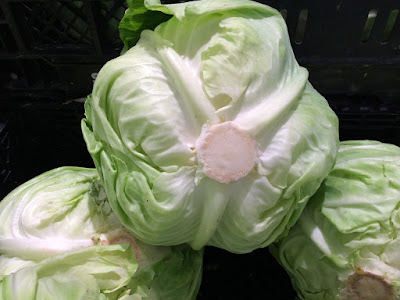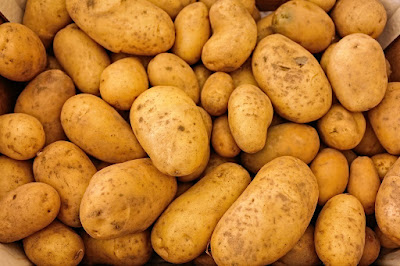Interesting facts about spices, vegetables and fruits. History, production and usage trivia.
Friday, 30 September 2016
5 interesting facts about Wheat
1. Wheat is native to the Levant
region.
2. Wheat is grown on more
land area than any other commercial food. Currently, it is second only to rice
as a human food crop.
3. China is the world’s
largest producer of maize followed by India.
4. World trade in wheat is
greater than for all other crops combined!
5. Apart from white and red
wheat, other naturally evolved species include black, yellow and blue wheat!
Thursday, 29 September 2016
5 interesting facts about Maize
1. Maize is native to the Mexico.
2. Maize is biologically a
kernel. It is often erroneously called a seed.
3. The United States is the
world’s largest producer of maize followed by China.
4. Maize ears along with
tobacco leaves are carved into the capitals of columns in the United States
Capitol building.
5. Maize is used as fish bait
in coarse fishing and by hunters as bait for animals like deer and wild hogs.
Wednesday, 28 September 2016
5 interesting facts about Papaya
1. The Papaya is native to the
Tropic of Americas.
2. Papaya plants grown in
three sexes: Male, female and hermaphrodite. All commercial papaya orchards only
contain hermaphrodites.
3. India is the world’s
largest producer of Papaya followed by Brazil.
4. Green Papaya and the tree
latex contain papain which is used to
tenderize meat.
5. The Papaya tree was the
first transgenic fruit tree to have its genome sequenced.
Tuesday, 27 September 2016
5 interesting facts about Cherries
1. The Cherry is native to the
Northern Hemisphere (America, Europe and Asia).
2. The Cherry is part of the
Rosaceae family. Other members of this family include almonds, peaches,
apricots, plums and of course, roses!
3. Turkey is the world’s
leading producer of Cherry followed by the United States.
4. A chemical reaction
between cherries and alkaline products like baking powder causes a blue
discoloration in baked goods.
5. The wood of some cherry
trees is especially esteemed for the manufacture of fine furniture.
Monday, 26 September 2016
5 interesting facts about Cashew nuts
1. The Cashew nut tree is
native to Brazil.
2. Vietnam is the world’s
largest producer of Cashew Nuts, followed by Nigeria.
3. The shell of the Cashew
Nut contains oil compounds which cause contact dermatitis. This is similar in
intensity to that caused by poison ivy!
4. In traditional Mayan
medicine, the leaves and bark of the Cashew tree are used in a tea to treat
diarrhea!
5. Alcoholic drinks can be
produced by fermenting the cashew apple.
Sunday, 25 September 2016
5 interesting facts about Peanuts
1. Peanuts are native to South
America.
2. The Peanut is not really a
nut. Biologically, it is classified as a legume. However, for culinary reasons it
is accepted as a nut.
3. China is the world’s
leading producer of peanuts followed by India.
4. Paint, varnish, furniture
polish, insecticides, soap, cosmetics and nitroglycerin are some industrial products made
with peanut oil.
5. Peanuts can also be used
to make peanut-milk, a kind of lactose-free milk like beverage that helps fight
malnutrition in Africa.
Saturday, 24 September 2016
5 interesting facts about Beetroot
1. Beetroot is presumed to be
native to Scandinavia.
2. The original beet roots
were long and thin like carrots. The modern round beetroot is presumed to have
appeared only after the 16th century.
3. Russia is the world’s
largest producer of beetroot followed by France.
4. Apart from being used as
food, beetroot is commonly used as a coloring agent and as medicine.
5. Beetroot can also be used
to make wine!
Friday, 23 September 2016
5 interesting facts about Spinach
1. Spinach is native to Ancient
Persia.
2. Spinach is related to
beets and belongs to the same family!
3. China is the world’s
leading producer of Spinach followed by the United States.
4. Spinach contains an
appreciable amount of iron. However it also contains oxalate – an iron-absorption
inhibiting substance!
5. The cartoon character
Popeye is credited in increasing US domestic consumption of spinach. Crystal
City, Texas has a statue of him!
Thursday, 22 September 2016
5 interesting facts about Cabbage
1. Cabbage is most likely
native to Europe.
2. China is the world’s
largest producer of cabbages followed by India.
3. The characteristic flavor
of cabbage is caused by glucosinolates,
a class of sulfur-containing glucosides.
When cabbage is overcooked, hydrogen sulfide
gas is produced!
4. In cuisine, cabbages can
be boiled, steamed, stewed, sautéed, braised, pickled, fermented for use in
Sauerkraut, or even eaten raw!
5. The ancient Romans described the medicinal properties of cabbage, recommending it
to counter drunkenness and cure hangovers!
Wednesday, 21 September 2016
5 interesting facts about Peaches
1. Peaches are native to
Northwest China.
2. Peaches are a type of
prune and are closely related to cherry, apricots, almonds and plums. They are a
member of the rose family.
3. China is the world’s
leading producer of Peaches followed by Italy.
4. Peaches have always been significant
in Oriental cultures like China, Japan, Korea and Vietnam. In Europe, several
renaissance artists have painted still life paintings of fruits with the peach
given a prominent position.
5. Some 110 chemical
compounds contribute to the characteristic peach aroma, including alcohols, ketones, aldehydes, esters,
polyphenols and terpenoids.
Tuesday, 20 September 2016
5 interesting facts about Watermelon
1. Watermelon is native to
Southern Africa.
2. The watermelon fruit is
actually a kind of berry. Botanically, it is called a Pepo.
3. China is the world’s
largest producer of watermelon, closely followed by Turkey.
4. Although the flesh is the
most often consumed part, some cuisines make use of the rind and even seeds.
Pickled watermelon rind is a Southern US speciality.
5. Naturally round
or oblong, farmers in the Zentsuji region of Japan have successfully grown
cubic watermelons! The shape was designed to make the fruit easier to stack.
Wednesday, 14 September 2016
5 interesting facts about Rice
1. Rice is native to China.
2. Rice is an agricultural
commodity with the third-highest worldwide production. China is the world
leader in production followed by India.
3. The largest collection of
rice cultivars, number over 100,000 is housed at the International Rice
Research Institute in the Philippines
4. Apart from being a staple
food source, rice and its by-products are used to make straw, rope, paper, wine,
biscuits, beer, cosmetics, packing materials and even toothpaste!
5. Two Japanese car brands
were named after rice. Toyota means ‘bountiful rice field’ and Honda means ‘the
main rice field’.
Tuesday, 13 September 2016
5 interesting facts about Potatoes
1. Potatoes are native to South
America.
2. Potatoes are the world’s
fourth largest food crop. China is the largest producer followed by India.
Together, these two countries account for a third of the world’s production.
3. There are over 5,000
varieties of potatoes grown worldwide. Nearly 3,000 varieties are found in the
Andes region alone. There are even purple and blue potatoes!
4. Potatoes contain toxic
compounds called glycoalkaloids. These are concentrated in the green flowers, sprouts
and leaves.
5. Vodka, Potcheen and
Akvavit are alcoholic beverages brewed from potatoes!
Monday, 12 September 2016
5 interesting facts about Oranges
1. Oranges are native to Southern
China and North-Eastern India.
2. Orange trees are estimated
to be the most cultivated fruit trees in the world! Brazil is the world’s
leading producer of oranges, followed by the United States.
3. Over two thirds of all
orange produce goes for juice extraction. The rest is sold as fruit or
converted to marmalade, preserves and Orange Oil.
4. After chocolate and
vanilla, orange is the world’s favourite flavor!
5. Orange peel is used by
gardeners as a slug repellent!
Sunday, 11 September 2016
5 interesting facts about Bananas
1. Bananas are native to tropical
Indo-Malaya and Australia.
2. The banana plant is the
largest herbaceous flowering plant. Indian is the world’s largest cultivator of
Bananas followed by China.
3. Nearly every part of the
banana plant is useful. The fruit is consumed either ripe or raw. The flowers
and trunk are used in Asian cuisine. The leaves are used as temporary utensils
or waterproof roofing. The fiber is used to make textiles and paper!
4. Because of their high
potassium content, Bananas are naturally radioactive!
5. The Banana has its own
emoji! The Unicode standard includes U+1F34C to represent the banana. In HTML,
this is 🍌.
Saturday, 10 September 2016
5 interesting facts about Onions
1. It is believed that onions
are native to Central Asia.
2. Over 170 countries produce
onions as a agricultural product. China is the largest cultivator closely
followed by India.
3. The stinging sensation
caused by freshly cut onions is due to the presence of the volatile gas
Syn-propanethial-S-oxide. This gas stimulates the nerves in the eyes.
4. Raw and cooked onions
contain traces of sulfoxide. While not harmful to humans, this could
potentially be deadly for dogs, cats, guinea pigs, monkeys and other animals.
5. Onions are also used in
divination! Divination by onions is called Cromniomancy!
Friday, 9 September 2016
5 interesting facts about Mangoes
1. The mango is native to
South Asia.
2. The mango is the
most-cultivated fruit in the tropics. India is the leading cultivator of the
Mango with almost 50% of global production. China is the second largest
producer.
3. The mango is the National
Fruit of India, Pakistan and the Philippines. The mango tree is the National
Tree of Bangladesh.
4. Mangoes are related to
cashews and pistachios.
5. Mango trees can grow up to
a 100 feet tall. Even trees as old as 300 years continue to bear fruits!
Thursday, 8 September 2016
5 interesting facts about Apples
1. Apples
are native to Central Asia.
2. There
are over 7,500 known varieties of Apples grown today. China leads with 49% of
the total world production.
3. The Apple tree was perhaps
the earliest tree to be cultivated. This is probably why Apples are remarkably
significant in many cultures including Norse, Greek and European Christian.
4. The seeds of Apples
contain a sugar and cyanide compound called cyanogenic glycoside. In small
doses, these are not harmful to humans.
5. Apples are actually part
of the Rose family – just like pears and plums!
Wednesday, 7 September 2016
5 interesting facts about Tomatoes
1. Tomatoes
are native to Central and South America.
2. Although
considered a culinary vegetable, a tomato is actually (biologically) a fruit!
3. Tomatoes
are the eighth most valuable agricultural commodity worldwide. Currently, China
is the world’s largest producer and exporter of tomatoes. India occupies second
place.
4. There
are over 7,500 varieties of tomatoes grown for various reasons. It is used in
diverse culinary ways including raw in salads, processed in juices and ketchup,
breaded and fried for salsa, pickled, as sauces etc.
5. Leaves,
stems and unripe green fruit of the tomato plant contain small amounts of the
toxic alkaloid tomatine. Tomato plants
can be highly toxic to dogs!
Tuesday, 6 September 2016
5 interesting facts about Fenugreek!
1. Fenugreek
is native to Iran and Iraq. It has also been found in the tomb of Tutankhamen
proving that the ancient Egyptians knew about it.
2. Fenugreek
is a semi-arid plant of the family Fabaceae.
It is used as a herb (dried or fresh leaves) spice (seeds) and vegetable (fresh
leaves, sprouts and micro-greens).
3. The
largest Fenugreek producer in the world is India. The state of Rajasthan
produces more than 80% of India’s output.
4. Fenugreek
is an important ingredient in South Indian, Turkish, Persian, Egyptian and
Jewish cuisine.
5. Highly
nutritious, 100 grams of Fenugreek leaves provide up to 40% the recommended
Daily Nutritional Value of Calcium.
Subscribe to:
Comments (Atom)






















